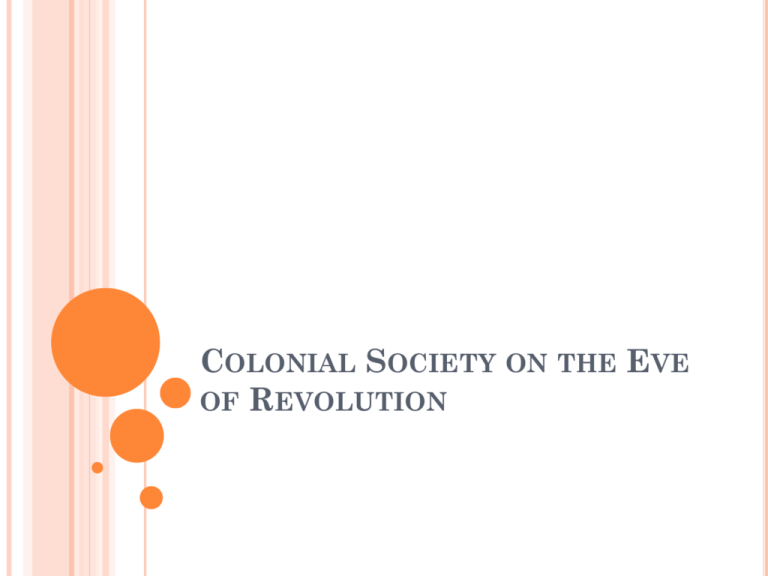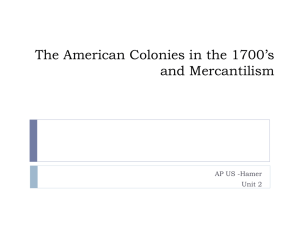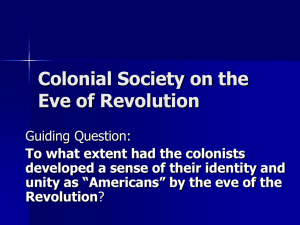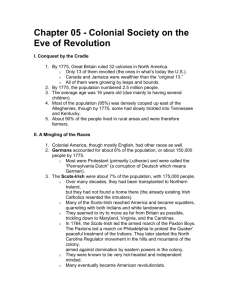File - Ms. Xiques' Classroom
advertisement

COLONIAL SOCIETY ON THE EVE OF REVOLUTION POPULATION BOOM In 1700 there were 250,000 people in the 13 colonies by 1775 they had a combined population of 2.5 million This increased population growth was due in part to the “forced immigration” of blacks and immigrants, but largely because of the natural fertility of the colonists TIPPING THE BALANCE In 1700 there was a ration of 20 to 1 English men to American colonists By 1775 the ratio had been reduced to 3:1 This helped to set the stage for a shift in the balance of power between Britain and the Colonies IMMIGRATION: GERMANS Germans made up about 6% of the colonial population by 1775 Settled mainly in Pennsylvania beginning in the early 1700’s as they fled religious persecution, economic oppression, and war Falsely referred to as the “Pennsylvania Dutch” Most were Lutherans IMMIGRATION: SCOTS-IRISH By 1775 made up 7% of population Not actually Irish, they are Scottish but fled from Ireland early in the 1700’s to escape persecution of their Scottish Presbyterianism from the strict Irish Catholics Upon settlement in America, pushed out on to frontier and became frontiersmen ETHNIC DIVISIONS IN 1775 IMMIGRATION: AFRICANS “Forced Immigration” Brought over as slaves By 1775 made up 20% of population (largest nonEnglish group) Largest concentration in the south as the south held 90% of the slaves MINGLING OF THE RACES By 1775, French Huguenots, Welsh, Dutch, Swedes, Jews, Irish, and Swiss were all on the list of immigrants Americans were of all races and mixed bloods, so other countries had a hard time classifying them. The South is typically associated with being the least ethically diverse of the colonies while the Middle colonies are associated with being the most ethically diverse COLONIAL SOCIETY In comparison to the class structure in Europe, America appeared as a land of equality Slavery was the only exception COLONIAL SOCIETY ON THE EVE OF REVOLUTION (NORTH) Beginning to show signs of class barriers “Gods of War” became increasingly wealthy as military suppliers Widows and Orphans resulted from the war and developed need for charities and almshouses The number of poor people rose furthering the divide between the classes COLONIAL SOCIETY ON THE EVE OR REVOLUTION (SOUTH) The large planters and farmers became wealthy thanks to their slave labor Lower classes were enlarged as indentured servants and convicts were sent to America Slaves were still the lowest of all the classes PROFESSIONS Christian ministry was the most honored profession Lawyers and Physicians were usually less esteemed bleeding was a common practice by doctors and not very successful PLAGUES Smallpox (afflicting 1 of 5 persons) was rampant a crude form of inoculation for it was introduced in 1721. Some of the clergy and doctors didn’t like the inoculation though, preferring not to tamper with the will of God. AGRICULTURE Agriculture was the leading industry Farmers could seemed to have the ability to grow anything. Tobacco was the staple crop in many of the middle and southern colonies Southern colonies also grew indigo and rice since many of the African slaves knew how to grow these crops TRADE also a prevalent industry, as commerce occurred all around the colonies. The triangular trade was common: New England sent rum and other manufactured goods to West Coast of Africa and traded it for African slaves which were sent to West Indies in exchange for molasses (for rum) and other raw materials like naval stores TRIANGULAR TRADE MANUFACTURING Not as important as other industries Laborers and skilled craftspeople were scarce Lumbering was most important manufacturing activity In addition to lumber, the northern colonies exported other naval stores to Britain for ship building MOLASSES ACT 1733, Parliament passed the Molasses Act Designed to hinder American international trade by prohibiting it’s trade with French West Indies Colonies were angered and responded by going around the with smuggling HORSEPOWER AND SAILPOWER Roads in 1700s America were very poor, and they only connected the large cites. Roads were so bad that they were dangerous. As a result, towns seemed to cluster around slow, navigable water sources, like gentle rivers, or by the ocean. Taverns sprang up to serve travelers and were great places of gossip and news. An inter-colonial mail system was set up in the mid-1700s, but, since there was nothing else to do, mailmen often passed time by reading private letters, DOMINANT DENOMINATIONS Two established churches (tax-supported) by 1775: Anglican and the Congregational. The Church of England (the Anglican Church) was official in Georgia, both Carolinas, Virginia, Maryland, and a part of New York. The Congregational church had grown from the Puritan church, and it was established in all the New England colonies except for Rhode Island. THE GREAT AWAKENING A religious revival which sought to revitalize religion through the emphasis of emotion in Jonathan Edwards & George Whitefield were fiery, passionate preachers and leaders of the Great Awakening More traditional orthodox clergy men, the “old lights,” were very skeptical of the new style of preaching which the “new lights” advocated JONATHAN EDWARDS was a fiery preacher who described the treacherous conditions of eternal damnation. began preaching in 1734, his methods sparked debate among his peers “Sinners in the Hands of an Angry God,” GEORGE WHITFIELD Began 4 years after Edwards, but was even more successful in moving his audience A very talented orator who could be extremely persuasive Imitators copied his emotional shaking sermons and his heaping of blame on sinners. SCHOOLS AND COLLEGES Because of plantation farming, the South was spread out and featured very few schools; however, the North, which focused on the community, emphasized education and the construction of schools Education was most prevalent in New England, where schools were originally used to train young future clergymen. The were some primary and secondary schools in other areas, but only children of wealthy families could afford to attend Most of the emphasis was placed on religion, classical languages, doctrine and orthodoxy. ART AND ARCHITECTURE Painters (usually looked down upon) John Trumbull Charles Willson Peale, best know for his portraits of George Washington Benjamin West and John Singleton Copley had to go to England to complete their ambitious careers. Architecture was imported from the Old World and modified to meet American needs. The log cabin was borrowed from Sweden. The classical, red-bricked Georgian style of architecture was introduced about 1720. LITERATURE Phillis Wheatley, who had never been formally educated published a book of verse other polished poems that revealed the influence of Alexander Pope. Ben Franklin’s Poor Richard’s Almanack was very influential, containing many common sayings and phrases, and was widely read in America and Europe THE PRESS There were many hand-operated presses that could cranked out leaflets, pamphlets, and journals Allowed for an increased spread of information and exposure of world issues John Peter Zenger was a New York newspaper printer who was taken to court and charged with seditious libel THE ZENGER CASE Peter Zenger was sued for seditious libel The judge urged the jury to consider whether or not publishing was a crime, no matter whether the content was derogatory or not. Zenger won thanks to lawyer Andrew Hamilton and because he was able to provide evidence supporting his claims The importance—freedom of the press POLITICS By 1775, 8 of the colonies had royal governors. appointed by the king, while 3 had governors chosen by proprietors. Practically every colony utilized a two-house legislative body. Self-taxation with representation came to be a cherished privilege Some governors were extremely corrupt. Voting was limited to white male landowners However, the ease of acquiring land helped to make voting more easily attaianable EARLY COLONIAL AMUSEMENT In the South, card playing, horse racing, cockfighting, and fox hunting were fun as well as stage plays Lotteries were universally approved, even by the clergy because they helped raise money for churches and colleges. Holidays were celebrated, though New England typically didn’t participate 1775 America was described like a quilt, each individual in its own way, but all coming together to form one single, unified piece.








